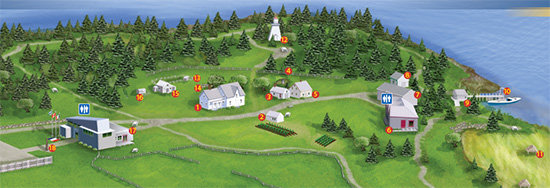Bilingual map of the historic acadian Village of Nova Scotia (PDF 12 MB)

In this early 1900s Acadian village, situated on a beautiful 17-acre site overlooking Pubnico Harbour, experience a language, culture, and way of life that has thrived along this shore for more than 250 years. Be welcomed into our homes, experience our traditional ways of farming and fishing and savour home-cooked Acadian cuisine in our café. Discover the industrious and joyful spirit that has kept our culture alive through deportation and hardship.
- Charles Duon House – 1832
This house was separated into two dwellings. The roof of the house’s main section originally had a gentle slope, but was raised and a gable was added – a trait common to many Acadian houses.
- Post Office – late 1800s
Built in West Pubnico, this building first served as a shoemaker shop, then became a rural post office I the early 1900s.
- Reuben Trefry Blacksmith Shop – late 1800s
Built in West Pubnico, this building served as the village’s blacksmith shop until 1938.
- Root Cellar
A root cellar is a structure that was built in the days before electricity in order to keep vegetables from freezing in the winter months and to keep its contents cool during the warm summer months.
- Maximin d’Entremont House – 1856
The roof features little or no overhang, an architectural trait common to many Acadian houses in Southwestern Nova Scotia.
- Amphitheatre – 2004
With 1680 square feet of space, this theatre provides a wonderful place to share the colourful history of the Acadians and their unique dances, music and stories.
- Boat Shop – 2004
Visit this reproduction of an early 20th Century boat ship, built in 2004, to see demonstrations of traditional boatbuilding.
- Augustin Duon Fish Store – 1875
Fish sheds once dotted the shore and served to process salted fish.
- Shanty – 2012
This building is a reproduction of a fishing shanty that was found along the shores of this region many years ago. Here is where the fishermen would repair their nets and lobster traps.
- Wharf – 2010
This is a crib style wharf similar to the small wharves that once dotted the shores in the region. Back in those days, fishermen had to plan their departure and return from fishing to coincide with the high tide in order to dock and unload their fish.
- Salt Hay Stacks
One of the greatest advantages of these marshes to the original settlers was the fact that they provided ready fodder for their cattle.
- Lighthouse – early 1900s
Constructed in the early 1900s on the mainland at Abbott’s Harbour, this lighthouse was built to replace a lantern hoisted on a mast on Abbott Island.
- Pigpen
A staple for Acadian families, pork was delicious salted and smoked and could be kept unrefrigerated for months.
- Stone Walls
These walls, which served as borders, were constructed from the stones gathered when clearing land for farms. Many of these old walls remain in Acadian villages today.
- Archange d’Entremont Shed – late 1800s
Originally used to prepare fish, this shed was later moved and used as a workshop. The outhouse, or “bécosse”, was added later.
- Chicken Coop
Chickens were kept all year for their eggs and meat.
- Visitor Reception and Administration Centre – 1999
Visitor Reception and Administration Centre. This centre features information on the Acadians of Nova Scotia, a boutique and café.
- Statue of Sieur Philippe Mius d’Entremont
This statue honours Philippe Mius-d’Entremont (1609-1699), the founder of Pobomcoup (Pubnico). James MacKay of Shelburne, Nova Scotia, carved this wooden statue.
Acadian Village, part of the Nova Scotia Museum family of museums, is located just minutes south of Highway 103. Take Exit 31 and travel for 10.3km on Route 335 South.
Site open 9am – 5pm daily.
Café open 11:30am – 3pm Monday to Friday.